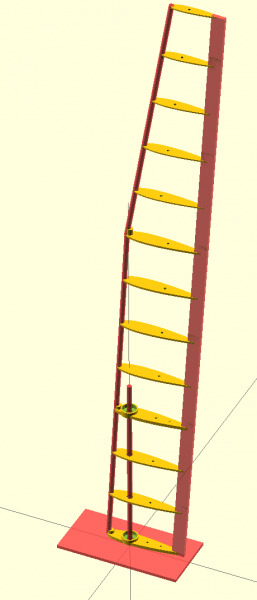The New Winged Sail
by Dermot Tynan in Microtransat
Posted on Wednesday, January 08, 2014 at 08:00
My original plan was to use a traditional mast and mainsail, with Yannick Lemonnier of West Sails volunteering to produce the sail. Yannick is no stranger to mad schemes himself, having competed in far too many Figaro races. These days, he spends his time sailing his Moth winged-beast, or racing his International 14. That is, when he's not making sails for everyone from Beoga Beag to the Volvo Open 70s.
Yannick had suggested using a Kevlar sail material, similar to the stuff they use for bullet-proof vests! However, after looking at the hull, he quickly decided that a solid "wing sail" was the only way to fly (pun most definitely intended). The OpenWing design has two wings which are hinged together. Usually, the wing is attached to the deck using a similar fitting to the average catamaran mast, with stays keeping the whole structure in place.
Each wing forms a NACA airfoil shape (similar to that used on the keel), with no camber. In other words, the airfoil is symmetrical. The airfoil I am using is the NACA0018, with a NACA0009 in the tail. The leading edge of the tail section is hinged onto the trailing edge of the forward section (for clarification, the CAD drawing here only shows the forward section, not the tail). The forward section pivots around a mast stub (shown as the vertical rod through the lower four struts). In my implementation, the mast is unstayed.
The two wings are coupled together in such a way that the incident angle between them can't be greater than around 30 or 40 degrees. The idea behind a wing-sail like this is that it will fly through the air and balance itself. The tail allows the boat to adjust the sail trim.
While this is a more involved mechanism from the traditional "stick and rags," it should be more robust than the alternative. Ideally, this structure would withstand a 360 degree roll, but that might be asking too much! If it doesn't tear like a normal sail would, it will be a definite improvement.
I'm hoping to have the first version of this beast assembled and ready to fly within the next few weeks. Just like the wind direction indicator, my plan is to put this baby outside and let Mother Nature kick it around for a while.
I'm looking forward to sailing the boat (manually) with this contraption installed, just to see how it works. Who knows, I might even make one for my Laser II.
Search
Upcoming Missions
- Galway Bay Loop, Waiting for Vessel Availability
Recent Posts
- May 2023 (1 post)
- April 2023 (1 post)
- March 2023 (1 post)
- February 2023 (2 posts)
- March 2022 (3 posts)
- March 2021 (1 post)
- August 2020 (1 post)
- May 2019 (1 post)
- April 2018 (1 post)
- November 2017 (1 post)
- April 2017 (1 post)
- November 2016 (1 post)
- September 2016 (1 post)
- August 2016 (1 post)
- January 2014 (2 posts)
- October 2013 (7 posts)
- September 2013 (1 post)
- August 2013 (3 posts)
- June 2013 (3 posts)
- May 2013 (4 posts)
- April 2013 (3 posts)
- March 2013 (9 posts)
- February 2013 (8 posts)
